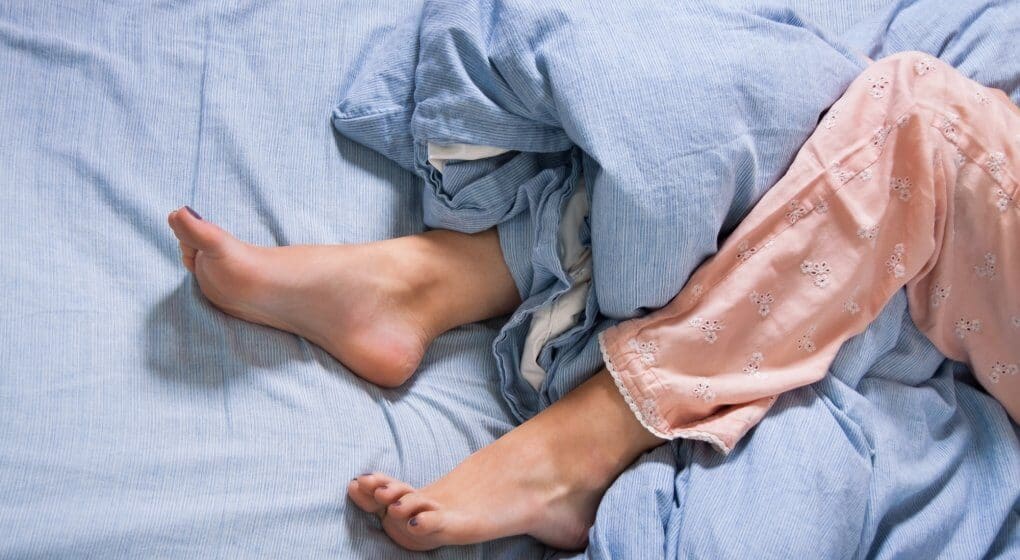
Have you ever felt the creepy crawlies climbing up your skin, or felt a persistent urge to keep moving? That pretty much sums up restless legs syndrome (aka RLS or Willis-Ekbom Disease) characterized by uncomfortable sensations in the legs that result in a persistent desire to keep moving. These unpleasant and unusual sensations are most frequently felt in the lower legs; hence, the name restless leg syndrome.
The propensity of the symptoms to either show up or aggravate at night, so much so that one is compelled to get out of bed and wander about, results in chaotic sleep patterns or insomnia in those affected by restless legs syndrome.
Though this syndrome is mainly a nervous disorder, it’s also recognized as a sleep disorder as it often interferes with sleep. All the same, it’s nothing like Forest Gump who felt the need to run and ended up running for 3 years and some more. In fact, the sensations in restless legs syndrome often come and go.
Restless legs syndrome is mentally taxing and physically annoying. According to the NIH, nearly 7-10% of the American population is affected by restless leg syndrome. Generally, women have a higher incidence of this syndrome than men. This disorder also tends to run in families, with more than half the people affected by restless leg syndrome having a family history of the condition.
Fortunately, restless leg syndrome can be treated even if it doesn’t have a cure. Several natural remedies have shown promise in improving its symptoms. In fact, the NIH states that most individuals with restless leg syndrome improve with non-drug treatments alone.
Symptoms of Restless Leg Syndrome
Restless leg syndrome is categorized as mild, moderate, and severe depending on the frequency of its symptoms. While moderate cases of restless leg syndrome may experience one or two episodes of these unpleasant sensations in a week, a severe case would experience them more than twice a week. If you experience the symptoms with an even lower frequency then you probably have mild restless leg syndrome.
Here’s a list of the symptoms of restless leg syndrome:
- Sensations of insects creeping or crawling up the skin or pulling, pinching, itching, and rarely dull pain in the lower limbs. Sometimes, these sensations are felt in the arms or other parts of the body as well, though they are most common in the legs.
- These sensations tend to appear when the lower limbs are still; hence, patients affected by restless legs syndrome often experience them during train or flight journeys or at the cinema.
- They also have a tendency to spiral higher in severity as the day progresses, especially at night.
- All of these sensations stop only on moving, which is why individuals with restless leg syndrome have this strong urge to get up and keep moving.
Lifestyle Changes for Restless Legs Syndrome
- At times, all you may need to control your restless legs are a few simple changes in your lifestyle.
- Some individuals find massaging the legs, alternately with hot or cool packs, beneficial. Additionally, daily low-intensity exercises like walking, jogging, or running for 30 minutes may help reduce the creepy sensations as well.
- Relaxation techniques like yoga, meditation, or tai chi are helpful.
- Early to bed and early to rise is a valuable mantra in tackling restless leg syndrome and its related sleep troubles. However, it’s all the more important to maintain a fixed schedule and train your body to sleep and wake up at more or less the same time every day.
- Cutting down on your caffeine intake also serves towards lessening restless leg syndrome. So, while you cut down on your daily cuppa coffee, make sure you watch the soft drinks and chocolates too as they are high in caffeine as well.
- Some researchers also believe that putting a full stop to or even reducing smoking and alcohol is a good shot at controlling restless leg syndrome.
Vitamins and Supplements:
Restless leg syndrome is frequently experienced by individuals with anemia. Keeping a check on your hemoglobin and iron levels and taking iron supplements may go a long way in improving restless leg syndrome.
Additionally, calcium and magnesium are minerals important for bone health and so increasing your intake of these through a healthy diet and sometimes supplements prescribed by a physician may help as well.
Vitamin B12 is important for nerve health and equally vital in improving a nervous disorder like restless leg syndrome.
Homeopathy for Restless Leg Syndrome
- Kali phosphoricum: If you experience restless legs along with a pricking sensation or numbness in your feet, Kali phosphoricum is likely to help.
- Tarentula hispanica: Tarentula hispanica is a remedy suited for dancers, and so a constant and compelling urge to get up and move might just find it’s nemesis in this homeopathic medicine.
- Argentum nitricum: When legs feel heavy like a log and the calves are rigid this is the remedy to go to.
- Rhus toxicodendron: Rhus toxicodendron works well in people who have an increased urge to move about at night and when moving makes symptoms better, whereas rest aggravates the symptoms. This pattern is typical to restless leg syndrome; hence, this remedy might serve well in treating it as well.
Herbs for Restless Leg Syndrome
- Valerian root: This herb is a natural sedative and was found to improve sleep disturbances and restless legs syndrome sensations in 37 patients as compared to placebo in a study performed at the University of Pennsylvania School of Nursing.
- Fava beans: This herb contains L dopa that increases the secretion of dopamine in the brain. Since, restless legs syndrome is associated with lower levels of dopamine, fava beans might possibly lower its uncomfortable symptoms.
- American skullcap: This herb is an excellent relaxant, due to which it has been used to treat restless legs syndrome for years.
Nonetheless, always use herbal cures cautiously and after speaking to your physician.
